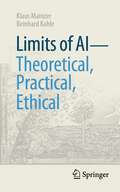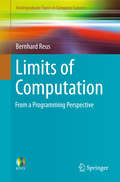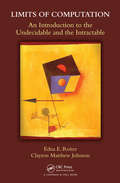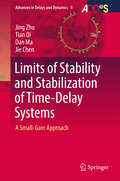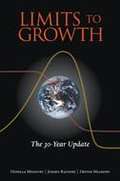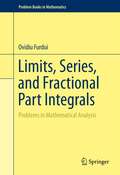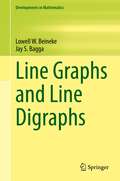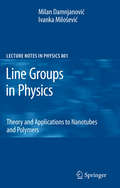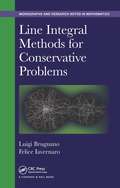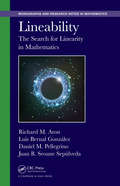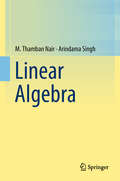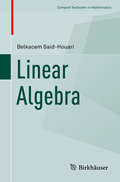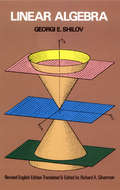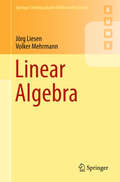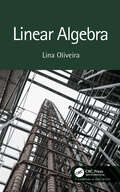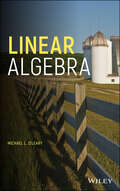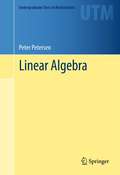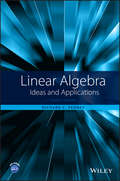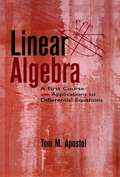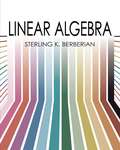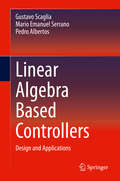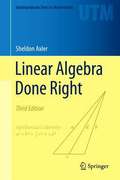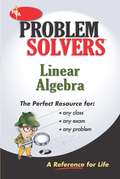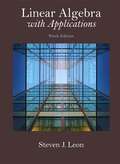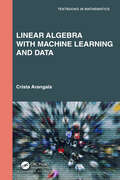- Table View
- List View
Limits of AI - theoretical, practical, ethical (Technik im Fokus)
by Klaus Mainzer Reinhard KahleArtificial intelligence is a key technology with great expectations in science, industry, and everyday life. This book discusses both the perspectives and the limitations of this technology. This concerns the practical, theoretical, and conceptual challenges that AI has to face. In an early phase of symbolic AI, AI focused on formal programs (e.g., expert systems), in which rule-based knowledge was processed with the help of symbolic logic. Today, AI is dominated by statistics-based machine learning methods and Big Data. While this sub-symbolic AI is extremely successful (e.g., chatbots like ChatGPT), it is often not transparent. The book argues for explainable and reliable AI, in which the logical and mathematical foundations of AI-algorithms become understandable and verifiable.
Limits of Computation
by Bernhard ReusThis textbook discusses the most fundamental and puzzling questions about the foundations of computing. In 23 lecture-sized chapters it provides an exciting tour through the most important results in the field of computability and time complexity, including the Halting Problem, Rice's Theorem, Kleene's Recursion Theorem, the Church-Turing Thesis, Hierarchy Theorems, and Cook-Levin's Theorem. Each chapter contains classroom-tested material, including examples and exercises. Links between adjacent chapters provide a coherent narrative. Fundamental results are explained lucidly by means of programs written in a simple, high-level imperative programming language, which only requires basic mathematical knowledge. Throughout the book, the impact of the presented results on the entire field of computer science is emphasised. Examples range from program analysis to networking, from database programming to popular games and puzzles. Numerous biographical footnotes about the famous scientists who developed the subject are also included. "Limits of Computation" offers a thorough, yet accessible, introduction to computability and complexity for the computer science student of the 21st century.
Limits of Computation: An Introduction to the Undecidable and the Intractable
by Edna E. Reiter Clayton Matthew JohnsonLimits of Computation: An Introduction to the Undecidable and the Intractable offers a gentle introduction to the theory of computational complexity. It explains the difficulties of computation, addressing problems that have no algorithm at all and problems that cannot be solved efficiently. The book enables readers to understand:What does it mean
Limits of Stability and Stabilization of Time-Delay Systems
by Jie Chen Jing Zhu Tian Qi Dan MaThis authored monograph presents a study on fundamental limits and robustness of stability and stabilization of time-delay systems, with an emphasis on time-varying delay, robust stabilization, and newly emerged areas such as networked control and multi-agent systems. The authors systematically develop an operator-theoretic approach that departs from both the traditional algebraic approach and the currently pervasive LMI solution methods. This approach is built on the classical small-gain theorem, which enables the author to draw upon powerful tools and techniques from robust control theory. The book contains motivating examples and presents mathematical key facts that are required in the subsequent sections. The target audience primarily comprises researchers and professionals in the field of control theory, but the book may also be beneficial for graduate students alike.
Limits to Growth: The 30-Year Update
by Jorgen Randers Dennis Meadows Donella MeadowsJust over 30 years ago a path-breaking book was published called "The Limits to Growth." It posited the then controversial idea that unlimited growth on a finite planet would inevitably lead to ecological collapse. The book was translated into more than a dozen languages. Now "Limits to Growth: The 30 year Update" takes the analysis into the first decade of the 21st century to show that while the situation remains precarious, there is still time to bring the Earth back from the brink of ecological collapse.
Limits, Series, and Fractional Part Integrals
by Ovidiu FurduiThis book features challenging problems of classical analysis that invite the reader to explore a host of strategies and tools used for solving problems of modern topics in real analysis. This volume offers an unusual collection of problems -- many of them original -- specializing in three topics of mathematical analysis: limits, series, and fractional part integrals. The work is divided into three parts, each containing a chapter dealing with a particular problem type as well as a very short section of hints to select problems. The first chapter collects problems on limits of special sequences and Riemann integrals; the second chapter focuses on the calculation of fractional part integrals with a special section called 'Quickies' which contains problems that have had unexpected succinct solutions. The final chapter offers the reader an assortment of problems with a flavor towards the computational aspects of infinite series and special products, many of which are new to the literature. Each chapter contains a section of difficult problems which are motivated by other problems in the book. These 'Open Problems' may be considered research projects for students who are studying advanced calculus, and which are intended to stimulate creativity and the discovery of new and original methods for proving known results and establishing new ones. This stimulating collection of problems is intended for undergraduate students with a strong background in analysis; graduate students in mathematics, physics, and engineering; researchers; and anyone who works on topics at the crossroad between pure and applied mathematics. Moreover, the level of problems is appropriate for students involved in the Putnam competition and other high level mathematical contests.
Line Graphs and Line Digraphs (Developments in Mathematics #68)
by Lowell W. Beineke Jay S. BaggaIn the present era dominated by computers, graph theory has come into its own as an area of mathematics, prominent for both its theory and its applications. One of the richest and most studied types of graph structures is that of the line graph, where the focus is more on the edges of a graph than on the vertices. A subject worthy of exploration in itself, line graphs are closely connected to other areas of mathematics and computer science. This book is unique in its extensive coverage of many areas of graph theory applicable to line graphs. The book has three parts. Part I covers line graphs and their properties, while Part II looks at features that apply specifically to directed graphs, and Part III presents generalizations and variations of both line graphs and line digraphs.Line Graphs and Line Digraphs is the first comprehensive monograph on the topic. With minimal prerequisites, the book is accessible to most mathematicians and computer scientists who have had an introduction graph theory, and will be a valuable reference for researchers working in graph theory and related fields.
Line Groups in Physics
by Milan Damnjanovic Ivanka MilosevicThis volume gives a detailed and up-to-date overview of the line groups, the groups that describe the symmetry of quasi-one dimensional crystals. Nanotubes, nanowires, nanosprings, nanorods, and polymers are examples remarkable enough to have kept nanoscience as a leading field within material science and solid state physics for more than fifteen years now. The authors present the mathematical foundations, including classifications of the line groups, quasi one-dimensional crystals and quantum numbers, together with important applications. Extensive illustrations related to the physics of nanotubes make the book essential reading in this field above all. The book clearly demonstrates how symmetry is a most profound property of nature and contains valuable results that are published here for the first time.
Line Integral Methods for Conservative Problems
by Luigi Brugnano Felice IavernaroLine Integral Methods for Conservative Problems explains the numerical solution of differential equations within the framework of geometric integration, a branch of numerical analysis that devises numerical methods able to reproduce (in the discrete solution) relevant geometric properties of the continuous vector field. The book focuses on a large
Lineability: The Search for Linearity in Mathematics (Chapman & Hall/CRC Monographs and Research Notes in Mathematics)
by Richard M. Aron Luis Bernal-Gonzalez Daniel M. Pellegrino Juan B. SepulvedaRenewed interest in vector spaces and linear algebras has spurred the search for large algebraic structures composed of mathematical objects with special properties. Bringing together research that was otherwise scattered throughout the literature, Lineability: The Search for Linearity in Mathematics collects the main results on the conditions for
Linear Algebra
by M. Thamban Nair Arindama SinghThis book introduces the fundamental concepts, techniques and results of linear algebra that form the basis of analysis, applied mathematics and algebra. Intended as a text for undergraduate students of mathematics, science and engineering with a knowledge of set theory, it discusses the concepts that are constantly used by scientists and engineers. It also lays the foundation for the language and framework for modern analysis and its applications. Divided into seven chapters, it discusses vector spaces, linear transformations, best approximation in inner product spaces, eigenvalues and eigenvectors, block diagonalisation, triangularisation, Jordan form, singular value decomposition, polar decomposition, and many more topics that are relevant to applications. The topics chosen have become well-established over the years and are still very much in use. The approach is both geometric and algebraic. It avoids distraction from the main theme by deferring the exercises to the end of each section. These exercises aim at reinforcing the learned concepts rather than as exposing readers to the tricks involved in the computation. Problems included at the end of each chapter are relatively advanced and require a deep understanding and assimilation of the topics.
Linear Algebra
by Belkacem Said-HouariThis self-contained, clearly written textbook on linear algebra is easily accessible for students. It begins with the simple linear equation and generalizes several notions from this equation for the system of linear equations and introduces the main ideas using matrices. It then offers a detailed chapter on determinants and introduces the main ideas with detailed proofs. The third chapter introduces the Euclidean spaces using very simple geometric ideas and discusses various major inequalities and identities. These ideas offer a solid basis for understanding general Hilbert spaces in functional analysis. The following two chapters address general vector spaces, including some rigorous proofs to all the main results, and linear transformation: areas that are ignored or are poorly explained in many textbooks. Chapter 6 introduces the idea of matrices using linear transformation, which is easier to understand than the usual theory of matrices approach. The final two chapters are more advanced, introducing the necessary concepts of eigenvalues and eigenvectors, as well as the theory of symmetric and orthogonal matrices. Each idea presented is followed by examples. The book includes a set of exercises at the end of each chapter, which have been carefully chosen to illustrate the main ideas. Some of them were taken (with some modifications) from recently published papers, and appear in a textbook for the first time. Detailed solutions are provided for every exercise, and these refer to the main theorems in the text when necessary, so students can see the tools used in the solution.
Linear Algebra
by Georgi E. ShilovCovers determinants, linear spaces, systems of linear equations, linear functions of a vector argument, coordinate transformations, the canonical form of the matrix of a linear operator, bilinear and quadratic forms, Euclidean spaces, unitary spaces, quadratic forms in Euclidean and unitary spaces, finite-dimensional space. Problems with hints and answers.
Linear Algebra
by Volker Mehrmann Jörg LiesenThis self-contained textbook takes a matrix-oriented approach to linear algebra and presents a complete theory, including all details and proofs, culminating in the Jordan canonical form and its proof. Throughout the development, the applicability of the results is highlighted. Additionally, the book presents special topics from applied linear algebra including matrix functions, the singular value decomposition, the Kronecker product and linear matrix equations. The matrix-oriented approach to linear algebra leads to a better intuition and a deeper understanding of the abstract concepts, and therefore simplifies their use in real world applications. Some of these applications are presented in detailed examples. In several 'MATLAB-Minutes' students can comprehend the concepts and results using computational experiments. Necessary basics for the use of MATLAB are presented in a short introduction. Students can also actively work with the material and practice their mathematical skills in more than 300 exercises.
Linear Algebra
by Lina OliveiraLinear Algebra is intended primarily as an undergraduate textbook but is written in such a way that it can also be a valuable resource for independent learning. The narrative of the book takes a matrix approach: the exposition is intertwined with matrices either as the main subject or as tools to explore the theory. Each chapter contains a description of its aims, a summary at the end of the chapter, exercises, and solutions. The reader is carefully guided through the theory and techniques presented which are outlined throughout in "How to…" text boxes. Common mistakes and pitfalls are also pointed out as one goes along. Features Written to be self-contained Ideal as a primary textbook for an undergraduate course in linear algebra Applications of the general theory which are of interest to disciplines outside of mathematics, such as engineering
Linear Algebra
by Michael L. O'LearyLINEAR ALGEBRA EXPLORE A COMPREHENSIVE INTRODUCTORY TEXT IN LINEAR ALGEBRA WITH COMPELLING SUPPLEMENTARY MATERIALS, INCLUDING A COMPANION WEBSITE AND SOLUTIONS MANUALSLinear Algebra delivers a fulsome exploration of the central concepts in linear algebra, including multidimensional spaces, linear transformations, matrices, matrix algebra, determinants, vector spaces, subspaces, linear independence, basis, inner products, and eigenvectors. While the text provides challenging problems that engage readers in the mathematical theory of linear algebra, it is written in an accessible and simple-to-grasp fashion appropriate for junior undergraduate students.An emphasis on logic, set theory, and functions exists throughout the book, and these topics are introduced early to provide students with a foundation from which to attack the rest of the material in the text. Linear Algebra includes accompanying material in the form of a companion website that features solutions manuals for students and instructors. Finally, the concluding chapter in the book includes discussions of advanced topics like generalized eigenvectors, Schur’s Lemma, Jordan canonical form, and quadratic forms. Readers will also benefit from the inclusion of:A thorough introduction to logic and set theory, as well as descriptions of functions and linear transformationsAn exploration of Euclidean spaces and linear transformations between Euclidean spaces, including vectors, vector algebra, orthogonality, the standard matrix, Gauss-Jordan elimination, inverses, and determinantsDiscussions of abstract vector spaces, including subspaces, linear independence, dimension, and change of basisA treatment on defining geometries on vector spaces, including the Gram-Schmidt processPerfect for undergraduate students taking their first course in the subject matter, Linear Algebra will also earn a place in the libraries of researchers in computer science or statistics seeking an accessible and practical foundation in linear algebra.
Linear Algebra
by Peter PetersenThis textbook on linear algebra includes the key topics of the subject that most advanced undergraduates need to learn before entering graduate school. All the usual topics, such as complex vector spaces, complex inner products, the Spectral theorem for normal operators, dual spaces, the minimal polynomial, the Jordan canonical form, and the rational canonical form, are covered, along with a chapter on determinants at the end of the book. In addition, there is material throughout the text on linear differential equations and how it integrates with all of the important concepts in linear algebra. This book has several distinguishing features that set it apart from other linear algebra texts. For example: Gaussian elimination is used as the key tool in getting at eigenvalues; it takes an essentially determinant-free approach to linear algebra; and systems of linear differential equations are used as frequent motivation for the reader. Another motivating aspect of the book is the excellent and engaging exercises that abound in this text. This textbook is written for an upper-division undergraduate course on Linear Algebra. The prerequisites for this book are a familiarity with basic matrix algebra and elementary calculus, although any student who is willing to think abstractly should not have too much difficulty in understanding this text.
Linear Algebra
by Richard C. PenneyPraise for the Third Edition "This volume is ground-breaking in terms of mathematical texts in that it does not teach from a detached perspective, but instead, looks to show students that competent mathematicians bring an intuitive understanding to the subject rather than just a master of applications."- Electric Review A comprehensive introduction, Linear Algebra: Ideas and Applications, Fourth Edition provides a discussion of the theory and applications of linear algebra that blends abstract and computational concepts. With a focus on the development of mathematical intuition, the book emphasizes the need to understand both the applications of a particular technique and the mathematical ideas underlying the technique. The book introduces each new concept in the context of an explicit numerical example, which allows the abstract concepts to grow organically out of the necessity to solve specific problems. The intuitive discussions are consistently followed by rigorous statements of results and proofs. Linear Algebra: Ideas and Applications, Fourth Edition also features: Two new and independent sections on the rapidly developing subject of wavelets A thoroughly updated section on electrical circuit theory Illuminating applications of linear algebra with self-study questions for additional study End-of-chapter summaries and sections with true-false questions to aid readers with further comprehension of the presented material Numerous computer exercises throughout using MATLAB® code Linear Algebra: Ideas and Applications, Fourth Edition is an excellent undergraduate-level textbook for one or two semester courses for students majoring in mathematics, science, computer science, and engineering. With an emphasis on intuition development, the book is also an ideal self-study reference.
Linear Algebra
by Tom M. ApostolDeveloped from the author's successful two-volume Calculus text this book presents Linear Algebra without emphasis on abstraction or formalization. To accommodate a variety of backgrounds, the text begins with a review of prerequisites divided into precalculus and calculus prerequisites. It continues to cover vector algebra, analytic geometry, linear spaces, determinants, linear differential equations and more.
Linear Algebra (Dover Books on Mathematics)
by Sterling K. BerberianA thorough first course in linear algebra, this two-part treatment begins with the basic theory of vector spaces and linear maps, including dimension, determinants, eigenvalues, and eigenvectors. The second section addresses more advanced topics such as the study of canonical forms for matrices. The treatment can be tailored to satisfy the requirements of both introductory and advanced courses. Introductory courses that also serve as an initiation into formal mathematics will focus on the first six chapters. Students already schooled in matrices and linear mappings as well as theorem-proving will quickly proceed to selected chapters from part two. The selection can emphasize algebra or analysis/geometry, as needed. Ample examples, applications, and exercises appear throughout the text, which is supplemented by three helpful Appendixes.
Linear Algebra Based Controllers: Design and Applications
by Gustavo Scaglia Mario Emanuel Serrano Pedro AlbertosThis book summarizes the application of linear algebra-based controllers (LABC) for trajectory tracking for practitioners and students across a range of engineering disciplines. It clarifies the necessary steps to apply this straight-forward technique to a non-linear multivariable system, dealing with continuous or discrete time models, and outlines the steps to implement such controllers. In this book, the authors present an approach of the trajectory tracking problem in systems with dead time and in the presence of additive uncertainties and environmental disturbances. Examples of applications of LABC to systems in real operating conditions (mobile robots, marine vessels, quadrotor and pvtol aircraft, chemical reactors and First Order Plus Dead Time systems) illustrate the controller design in such a way that the reader attains an understanding of LABC.
Linear Algebra Done Right
by Sheldon AxlerThis best-selling textbook for a second course in linear algebra is aimed at undergrad math majors and graduate students. The novel approach taken here banishes determinants to the end of the book. The text focuses on the central goal of linear algebra: understanding the structure of linear operators on finite-dimensional vector spaces. The author has taken unusual care to motivate concepts and to simplify proofs. A variety of interesting exercises in each chapter helps students understand and manipulate the objects of linear algebra. <p><p> The third edition contains major improvements and revisions throughout the book. More than 300 new exercises have been added since the previous edition. Many new examples have been added to illustrate the key ideas of linear algebra. New topics covered in the book include product spaces, quotient spaces, and dual spaces. Beautiful new formatting creates pages with an unusually pleasant appearance in both print and electronic versions. <p> No prerequisites are assumed other than the usual demand for suitable mathematical maturity. Thus the text starts by discussing vector spaces, linear independence, span, basis, and dimension. The book then deals with linear maps, eigenvalues, and eigenvectors. Inner-product spaces are introduced, leading to the finite-dimensional spectral theorem and its consequences. Generalized eigenvectors are then used to provide insight into the structure of a linear operator.
Linear Algebra Problem Solver (REA)
by The Editors of REAThe Problem Solvers are an exceptional series of books that are thorough, unusually well-organized, and structured in such a way that they can be used with any text. No other series of study and solution guides has come close to the Problem Solvers in usefulness, quality, and effectiveness. Educators consider the Problem Solvers the most effective series of study aids on the market. Students regard them as most helpful for their school work and studies. With these books, students do not merely memorize the subject matter, they really get to understand it. Each Problem Solver is over 1,000 pages, yet each saves hours of time in studying and finding solutions to problems. These solutions are worked out in step-by-step detail, thoroughly and clearly. Each book is fully indexed for locating specific problems rapidly. For linear algebra courses, as well as for courses in computers, physics, engineering, and sciences which use linear algebra. Concentrations on solutions to applied problems in economics, mechanics, electricity, chemistry, geometry, business, probability, graph theory, and linear programming.
Linear Algebra With Applications
by Steven LeonThis thorough and accessible text, from one of the leading figures in the use of technology in linear algebra, gives students a challenging and broad understanding of the subject. The author infuses key concepts with their modern practical applications to offer students examples of how mathematics is used in the real world. Each chapter contains integrated worked examples and chapter tests. The book stresses the important roles geometry and visualization play in understanding linear algebra.
Linear Algebra With Machine Learning and Data (Textbooks in Mathematics)
by Crista ArangalaThis book takes a deep dive into several key linear algebra subjects as they apply to data analytics and data mining. The book offers a case study approach where each case will be grounded in a real-world application. This text is meant to be used for a second course in applications of Linear Algebra to Data Analytics, with a supplemental chapter on Decision Trees and their applications in regression analysis. The text can be considered in two different but overlapping general data analytics categories: clustering and interpolation. Knowledge of mathematical techniques related to data analytics and exposure to interpretation of results within a data analytics context are particularly valuable for students studying undergraduate mathematics. Each chapter of this text takes the reader through several relevant case studies using real-world data. All data sets, as well as Python and R syntax, are provided to the reader through links to Github documentation. Following each chapter is a short exercise set in which students are encouraged to use technology to apply their expanding knowledge of linear algebra as it is applied to data analytics. A basic knowledge of the concepts in a first Linear Algebra course is assumed; however, an overview of key concepts is presented in the Introduction and as needed throughout the text.
